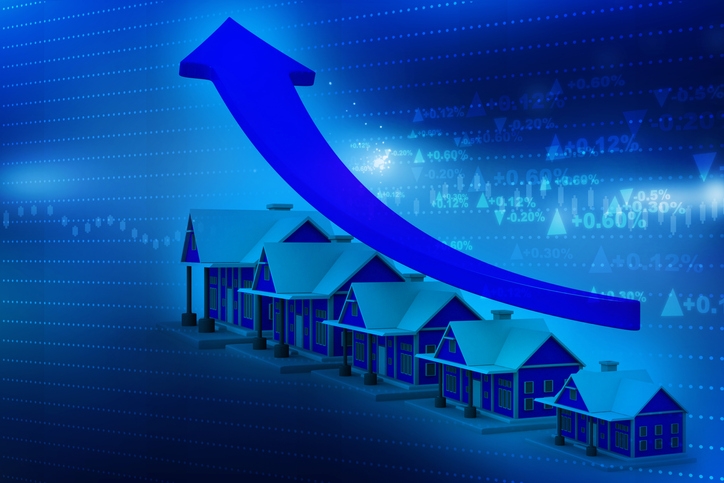Advertisement
Housing Starts Soared in December

The housing market ended 2019 on a major bang, with skyrocketing housing starts data compiled by the U.S. Census Bureau and Department of Housing and Urban Development.
Single-family housing starts in December were at a rate of 1,055,000, up 11.2 percent from the revised November figure of 949,000. Privately-owned housing starts in December were at a seasonally-adjusted annual rate of 1,608,000, soaring 16.9 percent above the revised November estimate of 1,375,000 and 40.8 percent above the December 2018 rate of 1,142,000. An estimated 1,289,800 housing units were started in 2019, which is 3.2 percent above the 2018 figure of 1,249,900.
Single-family authorizations in December were at a rate of 916,000, a 0.5 percent dip from the revised November figure of 921,000. Privately-owned housing units authorized by building permits in December were at a seasonally adjusted annual rate of 1,416,000, a 3.9 percent decline from the revised November rate of 1,474,000 but a 5.8 percent rise above the December 2018 rate of 1,339,000, which is 3.9 percent above the 2018 figure of 1,317,900.
Single-family housing completions in December were at a rate of 912,000, up 0.7 percent from the revised November rate of 906,000. Privately-owned housing completions in December were at a seasonally adjusted annual rate of 1,277,000, which 5.1 percent above the revised November estimate of 1,215,000 and 19.6 percent above the December 2018 rate of 1,068,000. An estimated 1,250,600 housing units were completed in 2019, up by 5.6 percent from the 2018 figure of 1,184,900.
Reaction from across the industry was positive, with observations that the market is eager to absorb new construction.
“An increase in housing stock is exactly what the market needs right now, since potential buyers have been fighting for homes that may have been on the market for as short as a single day,” said Bill Banfield, Quicken Loans’ chief risk officer. “This competition, due to low supply, has driven many areas to a point where first-time homebuyers do not have access to an inventory that matches their needs. I believe this increase in construction, if it continues, is the much-needed relief to increase the availability of homes to buy and especially for millennials who may have been waiting on the sidelines.”
“On a seasonally-adjusted basis, housing starts jumped in December to their highest level in 13 years,” said Mortgage Bankers Association Senior Vice President and Chief Economist Mike Fratantoni. “Surprisingly, single-family starts increased relative to November even on an unadjusted basis–unusual at this time of year–and was driven by a rise in the South. While single-family permits are up almost 11 percent relative to last year, the level suggests that this jump in starts is unlikely to persist, and we would expect them to return back below 1 million this spring. However, the trend in activity remains quite positive, and as more units are completed, inventories will grow, and this will support a faster pace of home sales in the spring of 2020.”
“As close to five million Millennials turn 30 this year and enter their prime homebuying stage,” said Realtor.com’s Senior Economist Geroge Ratiu. “Demand for housing is ramping up. Riding a wave of favorable financing, younger buyers have embraced homeownership, drying housing inventory to two-year low. With the generation’s rallying crying that there are not enough affordable homes, it is clear that there is ample room in the market for a significant increase in new construction, especially in the entry- and mid-level price segments.”
First American Deputy Chief Economist Odeta Kushi observed, “Limited existing homes available for sale have made for a competitive market, resulting in a busier-than-anticipated January. The market is ripe for homebuilders to ramp up new home construction to meet the growing demand. This month’s 10.8 percent year-over-year increase in single-family permits is a welcome sign of new inventory to come.”
Today’s housing starts data followed the slightly pessimistic one-point decline in the National Association of Home Builders (NAHB)/Wells Fargo Housing Market Index, which now reads at 75. However, the NAHB noted the last two monthly readings marked the highest sentiment levels in the history of the index since July 1999, and its leadership signaled an active 2020 for builders.
Today’s housing starts data followed the slightly pessimistic one-point decline in the National Association of Home Builders (NAHB)/Wells Fargo Housing Market Index, which now reads at 75. However, the NAHB noted the last two monthly readings marked the highest sentiment levels in the history of the index since July 1999, and its leadership signaled an active 2020 for builders.
“Low interest rates and a healthy labor market combined with a need for additional inventory is setting the stage for further home building gains in 2020,” said National Association of Home Builders (NAHB) Chairman Greg Ugalde, a home builder and developer from Torrington, Conn.
“With the Federal Reserve on pause and attractive mortgage rates, the steady rise in single-family construction that began last spring will continue into 2020,” said NAHB Chief Economist Robert Dietz. “However, builders continue to grapple with a shortage of lots and labor while buyers are frustrated by a lack of inventory, particularly among starter homes.”
About the author




